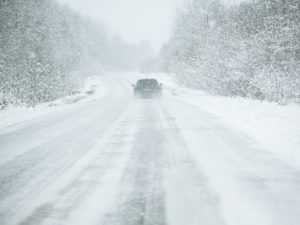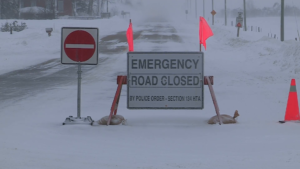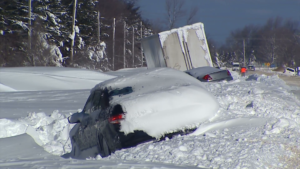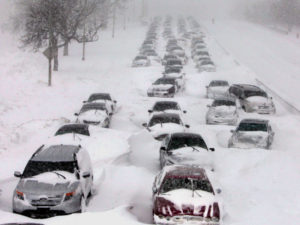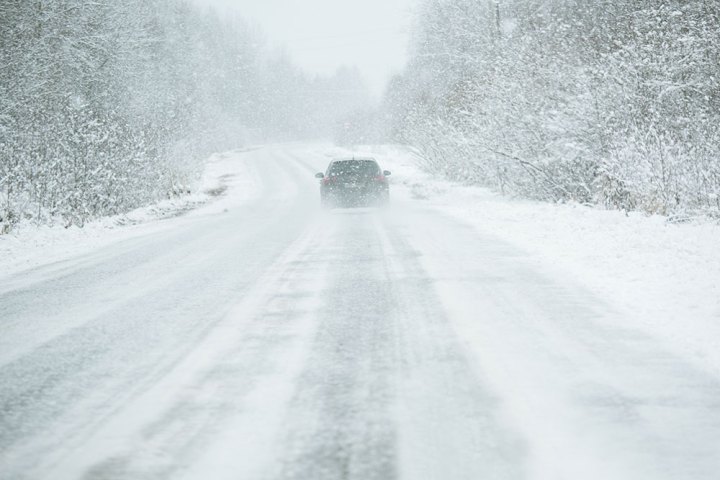
As we make our way through the last weeks of Fall and approach Winter, it’s time to do our twice-a-year vehicle change-over. For those of us who live in areas where snow and extreme cold are realities, being prepared for weather-related challenges is a wise investment.
As extreme and inclement weather, coupled with low temperatures, can negatively affect driving conditions, sometimes without warning. This time of year (approaching Christmas and New Year’s) sees us travelling to visit our friends and family, attending parties and generally spending more time on the roads. Roads that can sometimes go to hell real fast.
Be sure to get plenty of rest prior to a long road journey, stay hydrated and nourished and for the love of all that is holy, do NOT drive while impaired.
Winter weather brings with it snow storms, white-outs, icy roads (including black ice), freezing rain, traffic jams and accidents, breakdowns and more. A few well-focused steps and some essential equipment can mean the difference between a minor inconvenience, extreme discomfort or (in extreme cases) death. (Read a news article about a very unfortunate situation like this here.)
As the extreme cold and weather can hasten death under less-than-ideal circumstances, we look to some basic Survival Priorities to ensure a better chance of survivability. These principles include:
- Shelter
- Fire
- Water
- Signalling & Communication
- Food
- Security
*NOTE: These principles and their order of priority can and will change depending on your immediate circumstances. However, I have put them in this order at this time as a general theme and to illustrate their importance. The rationale is that, if you find yourself in a blizzard, shelter is paramount as you’ll freeze before the other considerations even enter into the equation. Then fire for warmth inside the shelter (car), and then water to keep your body functions going. Signalling for help would be next (flares, chemical lights, using a cell phone or radio) followed by food and security.***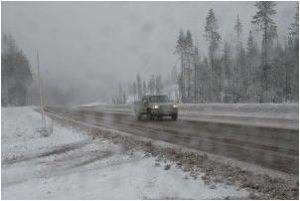
- Seasonal tires and Service. If you live in an area prone to winter weather, get snow tires, the best you can afford. Sure, you’ll have to switch between your All-Seasons and Winters, but well worth it for the better traction on snow and ice in colder temperatures. Also, be sure to get your car serviced at the same time to ensure maximum reliability through the winter. Have them check your battery, fluids, belts, lights, anti-freeze, windshield washer fluid (the -40 deg C kind) and the rest.
- Don’t Run Dry. If heading out of the city or for a longer drive, don’t let your car’s gas tank drop below half-tank on your journey. Stop frequently, top-off your gas tank and stretch. It also helps fight fatigue and gives you the opportunity to get food and drink regularly.
- Power-Up! Ensure you have a DC plug (cigarette plug) USB charger and charging cables for all your cell phones/devices. If there are more people in the car on your journey, run cables to as many phones as you can and charge them while driving, thus ensuring a full battery on as many devices as possible and a better chance for contacting help if needed.
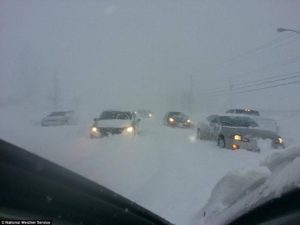
- Your Spare. If your car allows it, get a full-size spare tire and an appropriate tool kit. It should include a wrench for the lug nuts, a jack, nut lock tool (if your car has them), a small can of WD40 or similar, a small bottle of de-icer, block of wood for under the jack and a pair of warm work gloves. If you get a flat, you should know how to change it quickly and safely. Practice it in good weather so you know how to use all the tools and that the spare is in good repair.
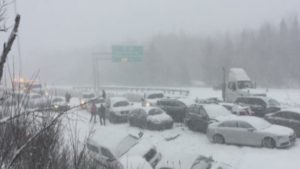
- Get a Grip. Stock a small shovel or entrenching tool and a bag of sand/gravel/cat litter to dig a wheel out of an icy patch and sprinkle the bag of sand under the tires to aid in the wheels gripping better. If your jurisdiction allows for chains, consider adding these to your kit and ensure you know how to put them on.
- Be Seen. Carry emergency triangles, at a minimum, and consider a few road flares or an electronic LED road flare to increase your visibility to other motorists. If the visibility is low, the likelihood of people seeing you and stopping is low. By the same token, if they can’t see you, you may be struck by other vehicles in the dark. In these situations, visibility is your friend.
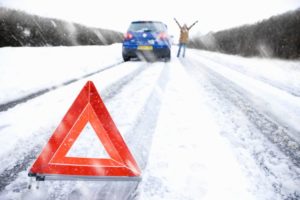
- Keep In Touch. If you’re travelling longer distances, communicate with your hosts and let them know when you’re leaving and when, approximately, you plan on arriving. If possible, let them know the route you’ll be taking. If it changes, send them a text to keep them updated. If you fail to show or get in touch by a pre-set time, they can call police on your behalf and search for you.
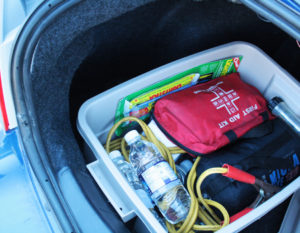
- Stock a Winter Emergency Kit. Split between your glove box and a backpack or duffel bag in your trunk with some emergency essentials can mean the difference between life and death in extreme circumstances. No, I’m not being dramatic, I’m being realistic. If you have ever spent a few hours in -35 in the middle of the night in a broken-down vehicle without and equipment hoping for someone to help, you’d appreciate it. I have. And despite knowing that “help was coming”, it was still terrible and very cold You can include the following items in an emergency kit as a start and add-on for your specific circumstances later. Here are the essentials:
- Snow brush & ice scraper;
- 2 emergency candles in a metal tin & 2 Bic lighters;
- Flashlight & spare batteries, A few glow stick Chem lights;
- First Aid kit with tourniquet (if you’ve not been trained, GO GET TRAINING!);
- Warm blankets or sleeping bag;
- Extra clothing (hats, gloves, socks, fleece jacket);
- Winter boots (like Sorel);
- Small bottle of lock de-icer or rubbing alcohol;
- Food (such as a few Cliff Bars or similar);
- A few bottles of water, plastic so as not to freeze and shatter);
- Metal cup;
- Consider a thermos filled with a hot drink;
- A quality multi-tool;
- Solid, full-tang knife;
- Seatbelt cutter (stowed above driver visor or accessible in centre console);
- A few contractor garbage bags;
- Whistle;
- 25′ of paracord;
- Small can of WD40 and small roll of duct tape;
- Basic tool kit for car;
- Wet wipes, small toilet paper & hand sanitizer;
- Jumper cables (for you and to help others);
- Extra cash and change (in small bills);
- Fire Extinguisher (small);
- Tow strap (if it can be attached to your vehicle);
- Extra fuel;
- Anything else you feel is necessary.
Staying in your vehicle, if possible, is the safest place to ride out a storm. It is a metal cage which protects you from other vehicles, but also from the elements. With the candles, blankets and extra clothes, you should be able to stay warm enough to survive. Adding food and possibly hot water, your chances go up even more. Adding to that higher levels of visibility and communications, your chances begin to climb higher.
If you do find yourself stranded, take immediate action to prepare yourself for a long stay.
- Stay CALM.
- Take stock of your situation. Stay in your vehicle.
- Attempt to make contact with Police or anyone who may be able to render aid.
- Remove your survival kit from your trunk to the back seat and break out its components while your engine is still running or is still warm.
- Deploy your visibility markers and, if visibility is low and it’s night out, consider your glow sticks, LED flares and chemical road flares.
- Use your shovel to clear the area around your exhaust pipe to prevent carbon monoxide from being pumped into your vehicle.
- Run the engine for 10-15 minutes at a time to conserve your battery and fuel.
- Ensure all unnecessary power expenditures (radio, phone use for games, etc, are cut. Only use your hazard lights if possible.
- Use the items in your kit to their maximum.
I trust this will serve as a solid primer to preparing you to deal with many unforeseen eventualities this winter driving season. Use common sense. If the weather is bad, stop. Reschedule. Turn Back. Get a hotel for the night. It’s not worth the risk. Don’t be caught unawares and unprepared this winter. Prepare now and get home safely.
Stay safe and stay crafty.

